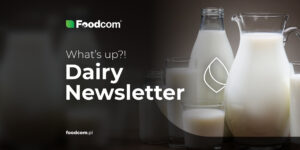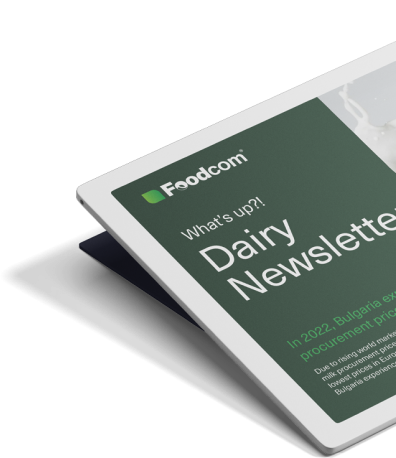- Price fluctuations and changing supply affect the stability of the global dairy market, especially in the milk powder, cheese and fat sectors.
- The first case of H5N1 avian influenza in humans in North America, linked to dairy cattle, raises public health concerns.
- The growing interest in high-protein, functional and fermented products is driving innovation in the dairy industry.
- The French dairy sector is facing a decline in the number of farms and dairy cows, which could affect national milk production.
Welcome Partners!
Welcome back to our newsletter!
The global dairy market is undergoing dynamic changes, influenced by price fluctuations, supply challenges and evolving consumer preferences. In this edition, we look at the latest trends in the markets for milk powder, cheese, fats and liquid products, where price adjustments and market adjustments may signal increasing volatility. We also analyse North America’s first human case of H5N1 D1.1 avian influenza linked to dairy cattle, growing demand for high-protein and functional products, and growing concerns about the future of French milk production. In the face of this uncertainty, the market is keeping a close eye on supply, prices and changing market dynamics.
Let’s take a look at what has been happening in the dairy market recently!
Milk powder
The European market for skimmed milk powder (SMP) has seen a slight decline, with prices currently at 2500EUR/MT. The food grade SMP segment remains stable or slightly strengthening, with fresh product holding at 2540EUR/MT, while lower quality offers are available at 2450EUR/MT. However, offers below 2400EUR/MT have disappeared from the market.
Wholesale prices for feed grade SMP remain at 2450EUR/MT for Q1, with a slight increase to 2500EUR/MT for Q2. Meanwhile, skimmed milk concentrate (SMC) prices have increased, with the German-origin product now quoted at 2050-2150EUR/MT FCA Germany. Market participants are closely monitoring supply developments in view of the upcoming seasonal increase in milk production, which could introduce further price fluctuations.
Cheese
The European cheese market remains resilient despite changes in demand and production dynamics. Gouda prices have risen slightly to 4350EUR/MT and edam is following this trend to reach 4300EUR/MT. Mozzarella remains stable at 4100EUR/MT, reflecting a balanced demand-supply situation. Emmental remains stable at 5200EUR/MT, with premium sliced products achieving higher prices due to limited availability.
Cheddar is also holding steady, with prices in the 4800-4900EUR/MT range, as supply in Europe remains steady, despite seasonal declines in milk production in Ireland and the UK. Producers are trying to secure sales for Q2, but buyers are holding off on decisions in anticipation of potential price falls due to the upcoming increase in milk supply.
In general, cheese producers are keeping a close eye on the milk fat market – falling fat prices could affect cheese margins. However, strong demand from the retail and foodservice sectors is helping to keep prices stable.
Fats
Butter prices in Europe have weakened, currently at 7100-7200EUR/MT, with Q2 contracts in the range of 6850-6950EUR/MT. Bids for February-March are in the range of 6850-7100EUR/MT, depending on origin. Despite the price correction, retail butter prices in Germany remain significantly higher, which continues to limit demand.
Anhydrous milk fat (AMF) remains strong at 9200-9400EUR/MT, supported by stable export demand from the confectionery sector. However, a weakening butter market and rising production costs could put downward pressure on prices in the coming months.
Liquids
The cream market in Europe continues its downward correction, with prices currently at 7900-8100EUR/MT FCA Germany. Cheaper offers from Poland are being reported, but the market remains under pressure from increasing milk supply.
Concentrated skimmed milk (SMC) prices have increased slightly, with the German-origin product currently quoted at 2050-2150EUR/MT FCA Germany. Market participants are keeping a close eye on supply developments, as restrictions in availability could lead to further price fluctuations.
Spot milk prices remain stable, with only minor adjustments, while payments to farmers fall slightly. The seasonal increase in milk production is starting to become noticeable, although the pace is moderate for now. With Q2 approaching, the market is monitoring the impact of rising milk volumes on the prices of cream and other dairy products.
Whey powder
The European market for whey powder (SWP) remains stable, with grocery prices at 1000-1080EUR/MT and demand remaining strong. Wholesale feed whey remains at 910EUR/MT, while its price for DAP Netherlands delivery increased to 950EUR/MT for Q1 and Q2.
Sweet whey concentrate prices have fallen significantly, reaching 700-800EUR/MT FCA. Meanwhile, whey protein concentrates (WPC) remain strong, with WPC 80 instant still above 11200EUR/MT and whey protein isolate (WPI), whose supply is extremely limited, trading above 20500EUR/MT in Europe.
Due to high demand from the nutrition and sports industry, WPI prices are likely to remain high. Limited availability is keeping the market tight, with some buyers already securing long-term contracts to avoid potential further rises. Due to ongoing supply constraints, further price increases in the whey protein market are possible.
What else?
North America
The first case of human infection with the new H5N1 avian influenza strain, designated D1.1, has been reported in Nevada. An infected dairy farm worker came into contact with infected cattle and experienced mild symptoms, mainly conjunctivitis. The patient is now recovering well and authorities stress that there is no evidence of human-to-human transmission of the virus, meaning that the risk to the general public remains low.
The D1.1 strain, previously detected mainly in wild birds and poultry, was recently identified in six dairy cow herds in Nevada. This is the first time this genotype of the virus has been found in cattle in the US. Experts point to a mutation in this strain that may facilitate its replication in mammals, including humans. Although there is currently no evidence of increased human-to-human transmission, scientists stress the need for further research into the potential public health risk.
Europe
The French agricultural sector is facing serious challenges that could threaten national food security. More than a quarter of dairy farms have closed in the past decade and forecasts show a further decline of 441,000 dairy cows by 2030. In addition, Lactalis, the world’s largest dairy producer, has announced a plan to reduce milk purchases in France by 450 million litres a year, almost 9% of its total volume in the country. The decision aims to reduce exposure to volatile commodity prices on international markets, but raises concerns among farmers about the future of domestic milk production.
In response to these challenges, French farmers are taking steps to diversify their sources of income and promote indigenous products. One example is the initiative of three female farmers in the Île-de-France region who have started producing ice cream with unusual flavours such as brie, mustard or beer, winning the approval of both local consumers and restaurateurs in Paris. This innovative approach not only supports the local economy, but also contributes to the preservation and promotion of the French culinary heritage.
NorthAmerica
In 2025 North America, the dairy industry is betting on the development of high-protein and functional products, responding to growing consumer interest in healthy food. Fermented dairy products, such as yoghurts and probiotic drinks, are particularly popular and are part of the trend to improve gut health and overall wellbeing. Curd, once somewhat forgotten, is returning to favour thanks to its high protein content and versatile culinary applications. The increase in sales of dairy ingredients, such as whey and colostrum, suggests that manufacturers are increasingly focusing on introducing innovative products with health-promoting value.
Another growth area is dairy drinks enriched with functional ingredients such as adaptogens, prebiotics or vitamins, which are part of the trend of so-called ‘wellness shots’. Consumers are looking for products that support immunity, mental health and body regeneration, which gives space for new milk-based formulas. Analysts predict that the category of high-protein snacks and beverages will continue to grow rapidly, creating an opportunity for manufacturers to strengthen dairy’s position in the healthy and functional food segment.
![Butter prices fall but AMF holds firm – what is driving the divergence? [255th Edition of DAIRY Newsletter] Butter prices fall but AMF holds firm – what is driving the divergence? [255th Edition of DAIRY Newsletter]](https://foodcom.pl/wp-content/uploads/2023/08/Foodcom_SA_Whats_up_Dairy_Newsletter-1520x760.jpg)





